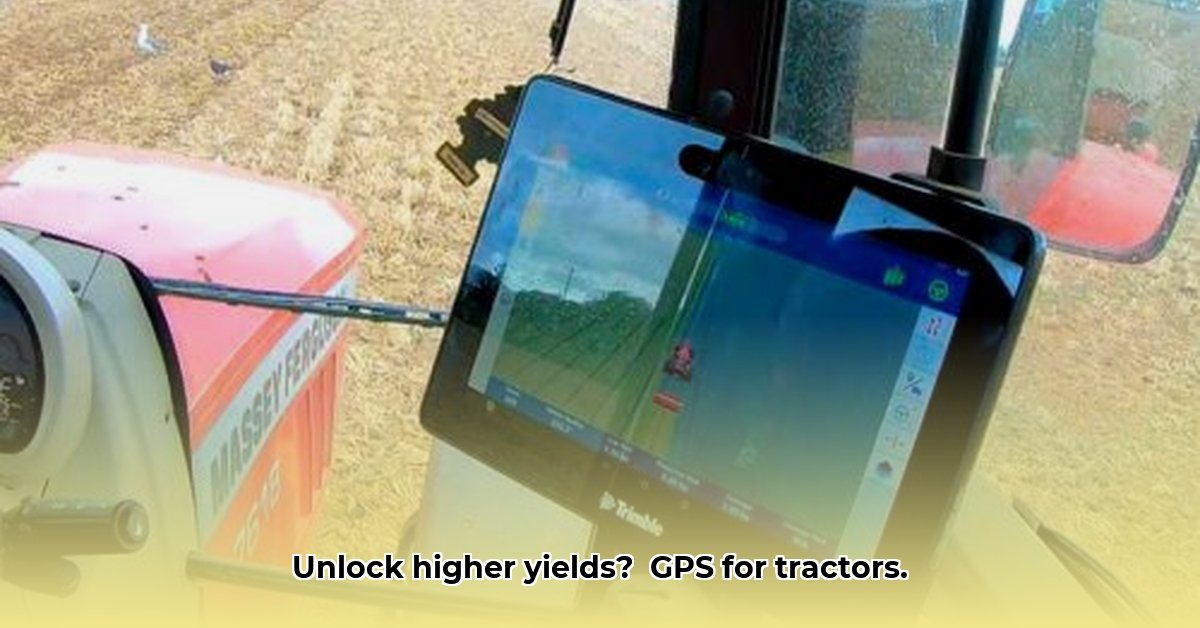
GPS technology has revolutionized farming, transforming from a futuristic concept to an indispensable tool for modern agriculture. This guide explains how GPS systems in tractors can enhance efficiency and profitability. We will explore various GPS systems, their advantages, and how to select the appropriate system for your operation. For smaller operations, consider compact tractor options.
Understanding Your GPS for Tractors Options
Choosing the right GPS system is akin to selecting the right tool for a specific job. Different systems offer varying levels of precision and cost, making the selection process crucial. Here's a breakdown:
Basic Guidance Systems: These systems provide basic location information, guiding you along pre-planned paths. This prevents overlaps and gaps, resulting in more consistent planting and spraying. They are a cost-effective starting point, suitable for smaller farms or those new to precision agriculture. Accuracy is typically within a few inches.
Differential GPS (DGPS): DGPS enhances accuracy by using correction signals from a reference station to improve the precision of the GPS signal. This offers a noticeable improvement over basic guidance, generally achieving accuracy within a couple of centimeters. It's a popular choice for farms balancing cost and accuracy needs.
Real-Time Kinematic (RTK): RTK GPS systems offer the highest accuracy, often within a centimeter or less, by correcting GPS signals in real time. This level of precision is vital for tasks demanding extreme accuracy, such as high-value crop planting or specialized spraying. It's the most expensive option but yields the greatest ROI for large-scale operations.
Here's a comparison table:
| System Type | Accuracy (Approximate) | Cost | Ideal For |
|---|---|---|---|
| Basic Guidance | ±15-30cm | Low | Smaller farms, general field operations |
| Differential GPS (DGPS) | ±3-5cm | Moderate | Most farms, improved accuracy needed |
| RTK | ±2-3cm | High | Large farms, high-precision operations, specialized tasks |
Why Use GPS for Tractors? The Benefits Are Clear
GPS offers significant advantages impacting profitability, productivity, and sustainable practices. Consider these key benefits:
Improved Efficiency: GPS minimizes waste by preventing overlaps and gaps in planting and spraying. This translates to significant savings on resources. Do you want to save time and resources on your farm?
Reduced Input Costs: Precise application of fertilizers and pesticides, guided by GPS, reduces waste and minimizes environmental impact. Studies suggest potential savings of 10-20% on input costs. How much could you save annually by optimizing fertilizer usage?
Increased Yields: Accurate planting and targeted applications lead to healthier crops and higher yields. This directly increases profitability. What's the potential yield increase with optimized fertilizer application?
Better Field Management: GPS provides valuable data for informed decision-making, resource allocation, and optimizing future planting strategies. Are you maximizing your land's potential to its fullest extent?
Reduced Labor Costs: Auto-steer, often integrated with GPS, can automate tractor guidance, potentially reducing labor requirements. This allows for more efficient use of labor in other crucial farm activities. How much labor could you potentially save with an auto-steer system?
Choosing the Right GPS for Tractors System: A Step-by-Step Guide
Selecting the right GPS system is a crucial decision. Follow these steps:
Assess Your Needs: Consider your budget, farm size, crop types, precision requirements, and integration capabilities with existing equipment.
Research and Compare Options: Explore various brands, models, and specifications. Carefully assess ongoing technical support and maintenance considerations.
Get Quotes and Compare: Request quotes from multiple suppliers and compare pricing, features, and warranty offerings. Negotiate if possible.
Installation and Training: Ensure professional installation and participate in thorough training on system operation and data analysis.
Integrating Your GPS for Tractors with Precision Farming
GPS is most effective when integrated with other precision farming technologies:
Auto-steer: Automates tractor steering based on GPS data, reducing fatigue and increasing efficiency.
Variable-rate technology: Allows for precise application of inputs according to real-time soil conditions and GPS data.
Yield monitoring systems: Track harvests based on location data, optimizing future planting strategies.
This integration amplifies the benefits of GPS, creating a synergistic system for increased efficiency.
Data Management: Turning Information into Action
GPS data can significantly optimize farm management. Farm management software helps analyze data to create detailed field maps, track yields, and identify areas for improvement. This data-driven approach leads to better decision-making and resource optimization.
Short-Term vs. Long-Term Investment
While initial investment may seem significant, the long-term ROI is substantial. Higher-accuracy systems may have a higher initial cost, but they often lead to greater long-term savings. Careful consideration of immediate budget constraints against projected long-term gains is essential. "The choice must balance your short-term budget against potentially sizable long-term gains," advises Dr. Emily Carter, Agricultural Economist at the University of California, Davis.
Conclusion
GPS technology is transforming modern agriculture, boosting efficiency and profitability while promoting sustainable practices. Embracing this technology is an investment in your farm's future. Staying updated on the latest advancements ensures you remain at the forefront of agricultural innovation.